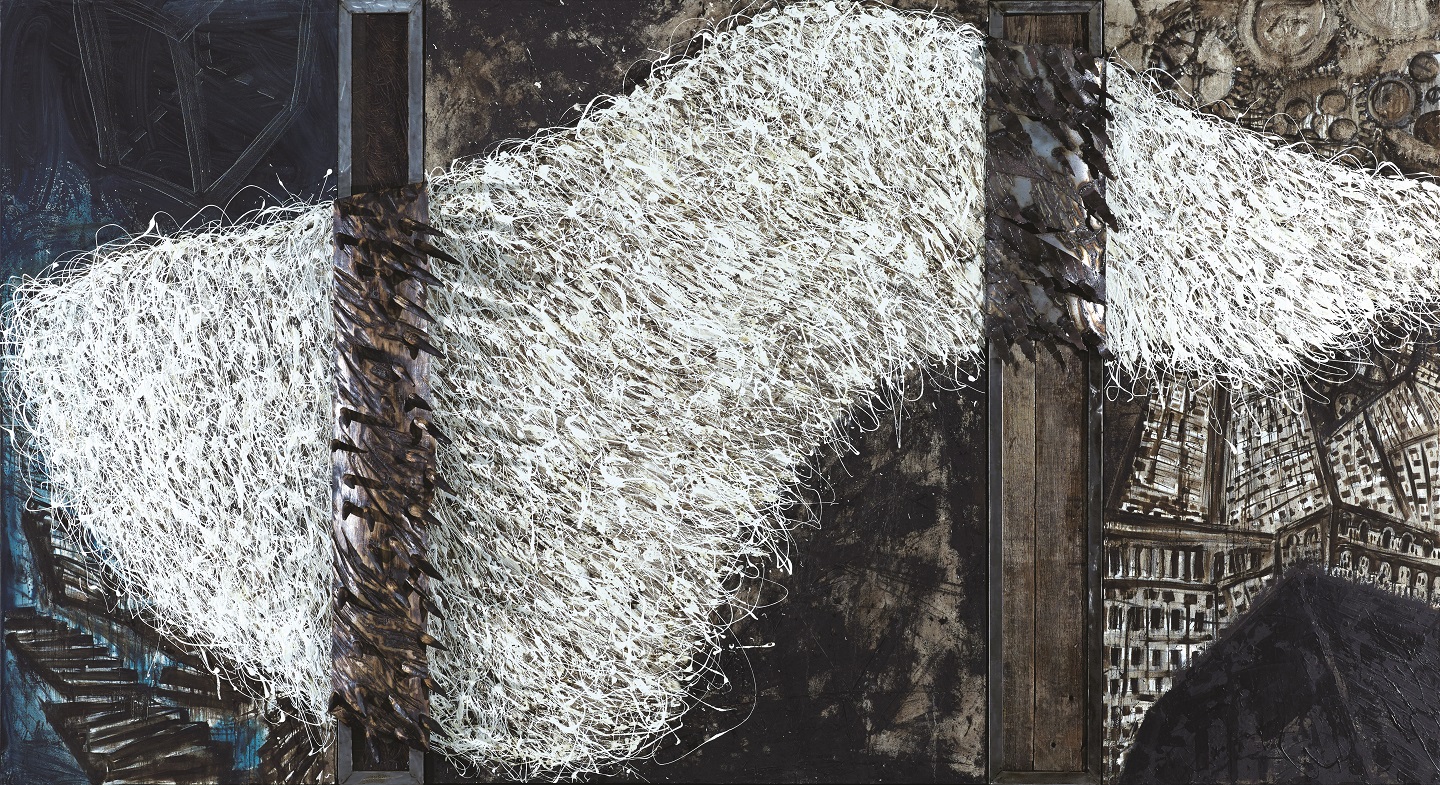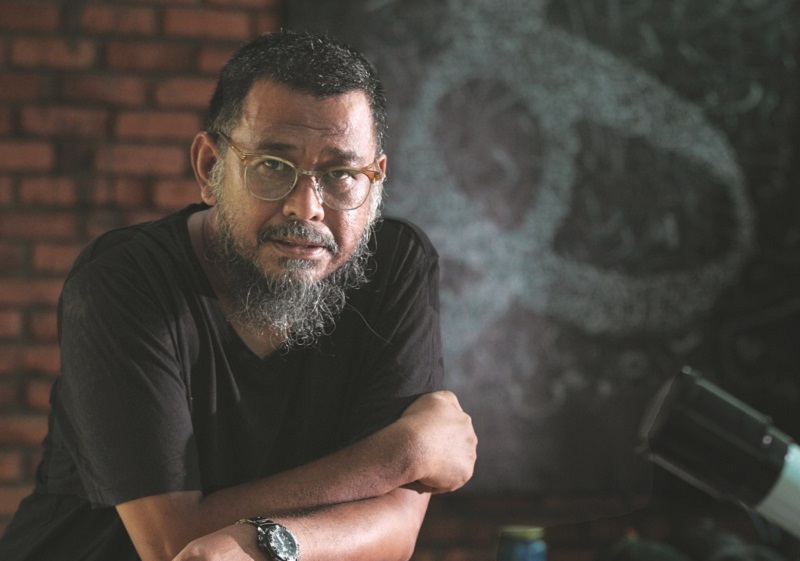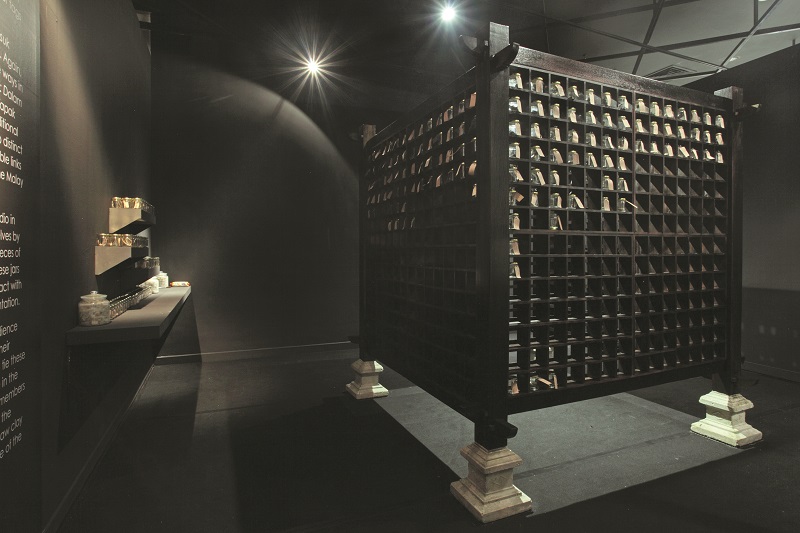
Penunggu Alam: Sayap Jibril incorporates elements from the land. (Photo: National Visual Arts Galllery)
Despite being born in Kuala Kangsar, Perak, Husin Hourmain did not grow up there. When he was 13, his family moved to Kuala Lumpur, where he completed his studies and spent much of his adult life.
Recalling what sparked his passion for painting, the 55-year-old says, “I couldn’t focus on my studies in school. Instead, I scribbled a lot in my notebooks. One day, I saw a group of men painting a movie poster and was fascinated by it. But my father wanted me to take up graphic design in college.”
Following his father’s wishes, Husin graduated from the Malaysian Institute of Art in 1982, majoring in commercial arts. But after 17 years of working in the design industry, he decided to call it quits and became a full-time artist instead. However, it was not plain sailing. “I was always painting in my free time. I thought I could do small design jobs while being an artist, but it didn’t work out. I had to sell my house because the mortgage was too high.”
Wanting to escape the hustle and bustle of Kuala Lumpur, Husin relocated to Perak three years ago. “If I hadn’t, I would have been stuck. Being in the contemporary art scene can be tiring. As an artist, I had to attend many exhibition openings and mingle. Collectors too wanted to visit me. [And because there are so many artists], the influence of others can jeopardise your thinking process,” he says.
Husin’s solo exhibition, Aku: dalam mencari rukun..., is the result of the relocation. “Even though it was my hometown, the environment was so different. I didn’t know what to expect. [The pace] was much slower; I had to adjust my mentality to suit those around me. But it was a good decision; there were no outside influences. It was a purely new experience and it allowed me to create new works.”

The show centres on the Rukun Iman (Six Principles of Islam). Compared with Husin’s previous works, this exhibition sees a change in his colour palette — dirty whites, earthy beiges and deep blues fill the paintings. The shift into darker tones is a clue to Husin’s soul-searching in the context of his spirituality and faith.
According to the artist, visualising the principles proved a challenge, given their intangible nature. An angel cannot be portrayed as human because it is not; Islam shies away from figurative illustrations in general and strictly forbids the depiction of Prophet Muhammad, or any prophet. So, Husin turned to abstraction and symbolism, making use of Arabic calligraphy, monoliths and, of course, the cube. The abundance of notes and sketches displayed in the exhibition show his meticulous thought and drafting process. The shape of a cube acts as the visual constant between the works and is used to represent the Kaaba (Islam’s most sacred site).
Two works stand out at the exhibition — Kunfayakun: Rasuk Bertiang Empat and Penunggu Alam: Sayap Jibril.
A reference to the Kaaba is most prominent in Kunfayakun: Rasuk Bertiang Empat, a wooden cube-like structure with square compartments. Husin invites visitors to partake in the installation, emphasising that the show is for everyone regardless of their religious background. Visitors are encouraged to mould a lump of clay to their liking and place it in a small jar. Their names and their date of birth as well as visit are then written on a tag and tied around the jar’s neck. The jar is then placed in a compartment of their choosing. The artist also pays homage to his Malay heritage by incorporating tapak gajah (traditional Malay stilts made of cement) and tanggam (interlocking pieces of wood) into the base of the structure. He says the connection between the audience and the artist plays a crucial part in the completion of the artwork.

Penunggu Alam: Sayap Jibril is a highly intense visual. Jibril is said to be an angel with wings that span light years. White paint is dripped across the triptych to form a large “wing”, almost taking up the entire surface. Differing backgrounds, ranging from clockwork gears above a skyline to a group of floating stairs against a dark blue, illustrate Jibril’s ability to travel between space and time. Rectangular structures made of wood and metal divide the canvases. The wood is from durian trees that were felled to make way for Husin’s studio in Perak, and in the Quran, metal is believed to have originated in a meteor crash. This work pays tribute to God’s creations and the land upon which Husin treads.
Throughout the exhibition, one can see that the works are not based merely on the Rukun Iman but also Husin’s life. The seamless merging of the two provides visitors with a hint of the importance of faith to the artist, and also to not be overwhelmed by the paintings.
Expressing his aspirations, Husin says, “I hope the show serves as a humbling experience for whoever visits. Everything that I’ve done is by God’s will. My inspirations and my every move are determined by Him. I also hope that this educates the younger generation of artists as well as the general public — to understand that art is not simply about splashing paint on a canvas. There is soul and knowledge in every piece of art.”
'Aku: dalam mencari rukun...', National Visual Arts Gallery, Jalan Temerloh, Titiwangsa, Kuala Lumpur. Until June 1. This article first appeared on May 14, 2018 in The Edge Malaysia.


